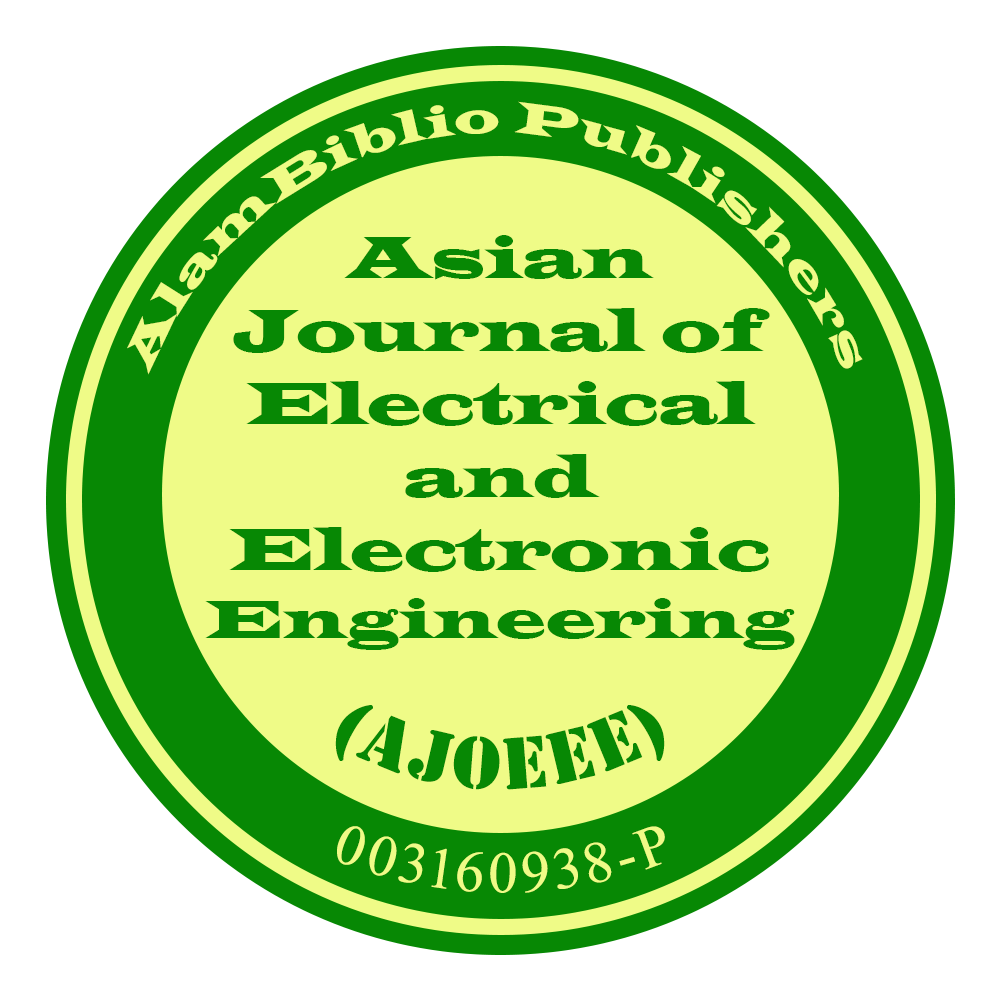Ferroelectric behavior and NCFETs - TCAD Simulation
DOI:
https://doi.org/10.69955/ajoeee.2021.v1i1.14Keywords:
MOSFET, NCFET, , Subthreshold slope, TCAD, FerroelectricAbstract
With the miniaturization of transistors, the current leakage also increases due to the increasing tunnelling effect. Plus, Boltzmann’s tyranny limits the subthreshold swing to be best and ideal at
60 mV/decade. Due to these, the power consumption in transistors keeps soaring up. Therefore, in this paper, the Negative Capacitance Effect Field Transistor (NCFET) is discussed as it possesses excellent potentials in reducing the power consumption in transistors. The negative capacitance induced in NCFET enables the internal voltage amplification and reduces the required voltage for the transistor to operate, and therefore, the power consumption is reduced. The literature reviews are done to gain knowledge on the structure and behavior of the NCFET. Next, the process and device simulation of NMOS are studied using Silvaco TCAD to get the idea of developing a circuit simulator model of NCFET. After that, we developed the circuit model of NCFET and MOSFET. Next, the ferroelectric parameters are varied to study how it will affect the ferroelectric material's polarization and capacitance. The ferroelectric thickness and source-drain doping concentration of the proposed NCFET model is also varied to study the NCFET behaviors in peak current, subthreshold slope, saturation current and saturation slope. Lastly, the performances of NCFET and MOSFET are compared. It is found that the NCFET has better performance as compared to the MOSFET as the NCFET can achieve a steeper subthreshold slope.
Downloads
References
S. Salahuddin and S. Datta (2008) Can the subthreshold swing in a classical FET be lowered below 60 mV/decade? Tech. Dig. Int. Electron Devices Meeting. pp. 693–696. https://doi.org/10.1109/IEDM.2008.4796789 DOI: https://doi.org/10.1109/IEDM.2008.4796789
Wang, H., & Wang, H. (2017). A Two-Terminal Active Capacitor. IEEE Transactions on Power Electronics, 32(8), 5893-5896.https://doi.org/10.1109/TPEL.2017.2668764 DOI: https://doi.org/10.1109/TPEL.2017.2668764
Catalan, G., Jiménez, D., & Gruverman, A. (2015). Negative capacitance detected. Nature Materials, 14(2), 137–139. https://doi.org/10.1038/nmat4195 DOI: https://doi.org/10.1038/nmat4195
Z. C. Yuan et al. (2016) Switching-Speed Limitations of Ferroelectric Negative-Capacitance FETs, IEEE Transactions on Electron Devices, vol. 63, no. 10, pp. 4046-4052. https://doi.org/10.1109/TED.2016.2602209 DOI: https://doi.org/10.1109/TED.2016.2602209
Bilal, B., Ahmed, S., & Kakkar, V. (2018). An Insight into Beyond CMOS Next Generation Computing using Quantum-dot Cellular Automata Nanotechnology. International Journal of Engineering and Manufacturing, 8(1), 25-37. https://doi.org/10.5815/ijem.2018.01.03 DOI: https://doi.org/10.5815/ijem.2018.01.03
Jo, J., Choi, W. Y., Park, J.-D., Shim, J. W., Yu, H.-Y., & Shin, C. (2015). Negative Capacitance in Organic/Ferroelectric Capacitor to Implement Steep Switching MOS Devices. Nano Letters, 15(7), 4553–4556. d https://doi.org/10.1021/acs.nanolett.5b01130 DOI: https://doi.org/10.1021/acs.nanolett.5b01130
Ko, E., Shin, J., & Shin, C. (2018). Steep switching devices for low power applications: negative differential capacitance/resistance field effect transistors. Nano Convergence, 5(1). d https://doi.org/10.1186/s40580-018-0135-4 DOI: https://doi.org/10.1186/s40580-018-0135-4
Michael Hoffmann, Franz Paul Gustav Fengler, Benjamin Max, Uwe Schroeder, Stefan Slesazeck, and Thomas Mikolajick (2019). Negative Capacitance for Electrostatic Supercapacitors. Adv. Energy Mater. 9: 1901154. https://doi.org/10.1002/aenm.201901154 DOI: https://doi.org/10.1002/aenm.201901154
Yadav, A.K., Nguyen, K.X., Hong, Z. et al. (2019). Spatially resolved steady-state negative capacitance. Nature 565: 468–471. https://doi.org/10.1038/s41586-018-0855-y https://doi.org/10.1038/s41586-018-0855-y DOI: https://doi.org/10.1038/s41586-018-0855-y
Masaharu Kobayashi, Toshiro Hiramoto (2016). On device design for steep-slope negative-capacitance field-effect-transistor operating at sub-0.2V supply voltage with ferroelectric HfO2 thin film. AIP Advances, 6(2). https://doi.org/10.1063/1.4942427 DOI: https://doi.org/10.1063/1.4942427
Muhammad A. Alam, Mengwei Si, and Peide D. Ye (2019) A critical review of recent progress on negative capacitance field-effect transistors Appl. Phys. Lett. 114, 090401. https://doi.org/10.1063/1.5092684 DOI: https://doi.org/10.1063/1.5092684
Cheng-I Lin, C., Khan, A. I., Salahuddin, S., & Hu, C. (2016). Effects of the Variation of Ferroelectric Properties on Negative Capacitance FET Characteristics, IEEE Transactions on Electron Devices, Vol 63 No. 5, pp- 2197 – 2199. https://doi.org/10.1109/TED.2016.2514783 DOI: https://doi.org/10.1109/TED.2016.2514783
Downloads
Published
Issue
Section
License

This work is licensed under a Creative Commons Attribution-NonCommercial 4.0 International License.
The Asian Journal of Electrical and Electronic Engineering journal is licensed under a Creative Commons Attribution-NonCommercial 4.0 International License.










